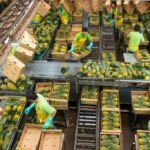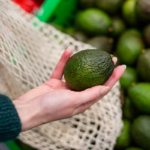Analysis of Peruvian fruit exports during the first half of the year

Recently, Fluctuante presented the latest report of Peruvian agro exports for the first six months of 2024. Freshfruitportal.com spoke with the CEO of Fluctuante, David Sandoval, who analyzed the behavior and current status of the main Peruvian fruits.
Sandoval said that the country has gone through a few challenges compared to last year due to adverse weather, “which has affected some products this year, specifically blueberries, where we have had a contraction at the beginning of this campaign, precisely because of the adverse changes of last year and that is just now being seen since it is mainly due to a late pruning”.
He added that agro-export products have not performed as positively as usual in the first half of the year, “but we have grown”.
Avocado
Regarding avocados, Fluctuante's CEO indicated that the sector is having problems because they are not meeting the required size.
He detailed that in the first semester, avocado was Peru's main agro-exporting product, with a share of 18% and a similar growth at the level of exported values in dollars.
“66% of exports go to the Netherlands, then follows Spain with 20% and the United States with a 12% share.”
As for the production areas, he pointed out that Lima, La Libertad, Lambayeque, Ica, and Ancash are the main locations.
“What we are looking forward to in the 2025 season is that we can play an important role in production and that the calibers increase,” he said.
Table grapes
Analyzing the table grape market, Sandoval explained that Ica is an important region for the production of the fruit, followed by Piura and Arequipa.
He added: “Grapes are the second most important product in the first half of 2024. We have reached three destination markets strongly; in first place is the United States with 48%, followed by Mexico with 11% and 9% to the Netherlands.”
Blueberries
The blueberry industry ranked third among the most important products in the period analyzed, with a growth of 112%.
“They have been atypical shipments because they were not so concentrated in the late months of last year, meaning October, November, and December, because those shipments shifted more towards the first months of this year. That is why we have had ample growth,” he said.
He explained that blueberries are suffering from cold weather. Additionally, they have had late prunings as a result of the low temperatures. “It is most likely that next year, growth will decrease compared to the first half of 2024.”
As for the markets, he said that the main destination is the United States with a concentration of 63%, followed by the Netherlands and the United Kingdom.
Mango
Mango is the sixth product in agricultural exports for Peru in 2024, with the main destinations being Europe, specifically the Netherlands, Spain, and the United Kingdom.
Sandoval explained that “almost a third of exports, representing 28% of shipments, go to the United States, where our main competitor is Mexico.”
He said that in 2023, agro exports from Peru were worth $10 billion in total. “To contrast, Mexico exported a little more than 60 billion dollars, six times more than what we export.”
Regarding the mangos in particular, he detailed that last year many were lost, specifically in the last months of the year, because the weather was not adequate for flowering, especially in Piura and Casma.
He explained that this year, producers are seeing more flowering, “which will allow them to have better fruit, a slightly larger sizes, and, in some areas, they are harvesting smaller mangoes that does not go for export.”
He also said that by the end of 2024, they expect mango production to start rising again.
He recommended that mango producers organize the supply and consider when they launch their product to the different markets, particularly in Europe and the United States, to prevent an excess supply during specific weeks.
He added that producers should organize themselves so that they do not all go out in the same window “and those who can lengthen their harvest period a little more, must get their fruit out a week later, so we do not have the complications of concentrated supply, which results in a lower price.”
Port of Chancay
The inauguration of the Port of Chancay, projected for November of this year, is approaching. In this regard, Fluctuante's CEO said that they hope that with the opening of the port, Peruvian products can reach the Asian markets in optimal conditions and in the promised time, “because that has been our biggest challenge when we have wanted to reach China, Japan, Taiwan, and South Korea, which is a very demanding market that demands a lot of fruit.”
He added that, once the port is inaugurated, it is projected that mainly grapes will be exported, “because Ica is a region with high grape production and the port is very close, so they will have fast access to export their fruits”.
China has a very strategic behavior from a commercial point of view in Peru, Sandoval said. “I think that if we move our pieces well, from the public and private sectors, so that we can have movement in the port of Shanghai with Peruvian products, they are going to be well received.”
He emphasized that results will not be seen in one or two years. "Most likely, as with all ports, we will see results in the medium to long term, in about five to ten years."
Recommendations
With a global view of the sector, Fluctuante's CEO gave some recommendations to the Peruvian fruit industry.
“It is important to have portions distributed among different markets and look for new niche markets. This strategy must come not only from the business sector but also from the government, to meet phytosanitary requirements for entering new markets."
He added that it is necessary to improve Peruvian land logistics because there is no road maintenance. “We have to improve many things, and one of them is the communication routes that we have in the interior of the country.”
He concluded by saying that “we must take great care of production, shipping periods and communication on the commercial side, because if we do not communicate with foreign customers, they do not know what product we have and if they do not know us, we will not be able to sell our products”.














































